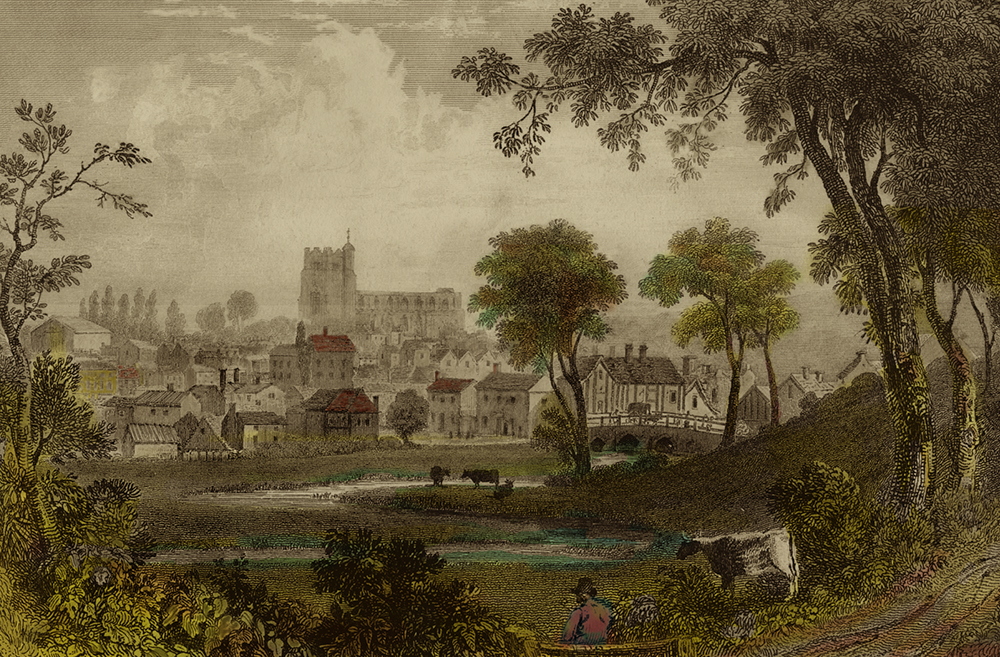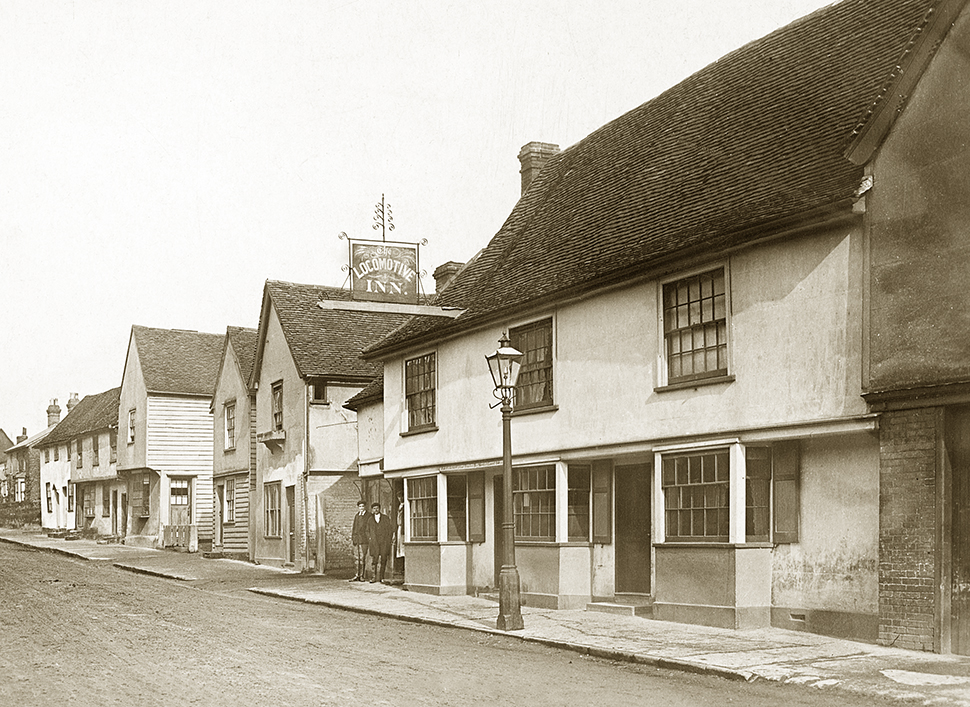THE COGGESHALL GANG

The Coggeshall Gang
“For some time past the neighbourhood of Coggeshall has been infested with a gang of housebreakers, who have carried out their work in a most audacious manner” The Essex Standard, June 1848
Between 1844 and 1848, a series of violent crimes took place in Coggeshall and the surrounding villages, which had the local inhabitants in fear for their safety. A group of up to fourteen men, known locally as the Coggeshall Gang, carried out the crimes. They had their headquarters at the Black Horse Inn, in Stoneham Street, the Landlord of which was William French, the half-brother of the leader of the gang, Samuel Crow.
French benefited from the proceeds of the crimes by receiving stolen property from the gang. Crow was employed in driving post- chaises for innkeepers and gentry and was well known in the neighbourhood. Armed with pistols and cudgels and wearing masks, the gang operated mainly at night and terrorised the local inhabitants.
Below is the old ‘Black Horse’ which was renamed the ‘Locomotive’ following the noteriaty of the Coggeshall Gang.

The first recorded crime occurred in November 1844, at the ‘Mount’ at the top of East Street/Colchester road. This was the unoccupied home of a Mr. Charles Skingsley, where assisted by the man supposed to be keeping guard, a quantity of wines stolen and the house burnt down to hide the crime.
In 1845, two burglaries were reported, one at the Bird in Hand Public House in East Street, and another in February 1845, at the warehouse of a Richard Bell, a grocer. The proceeds of this crime consisted of eight hams, worth £10, a quantity of bacon, 271b of candles and about seventeen cakes of soap. In 1847, another burglary took place and in 1848 no fewer than seven were reported to the police. It is possible that other offences went unreported.
In March 1848, at Bradwell-next-Coggeshall, four members of the gang entered a house and terrorised the occupants, James Finch, sixty-two years old and his house- keeper, Elizabeth Wright, for nearly three hours. During this time they were both held over an open fire to reveal where money was hidden and Elizabeth Wright was seriously injured when her clothes ignited. James Finch was also dragged upstairs, a rope tied round his neck and he was hoisted up to a beam. The gang helped themselves to food and drink, which they consumed on the premises. In addition to £6 in monies, they stole four hams, two pigs faces and half the contents of a tub of pork, all of which they carried away in a sack and basket. In another raid in that year the gang entered a house and threatened the frightened householder with a pistol. They then put a mattress on him, upon which they piled furniture and boxes, almost suffocating the poor man. The gang remained in the house for several hours, during which they consumed several bottles of wine before leaving with £5 in gold and silver.
The local police force found it difficult to catch the gang, but in 1847, one gang member, William Wade, had been caught through the efforts of one constable and at the Summer Assizes in that year he was sentenced to be transported for fifteen years. Whilst in Chelmsford Prison he was visited by Samuel Crow who promised to look after Wade’s wife if he kept quiet, but the gang failed to honour this agreement and the furious Wade informed the Governor of the prison of the identity of the other gang members. Magistrates at Witham were informed and warrants were issued for the arrest of William ‘Crusty’ Ellis, William Springett, William Tansley and Samuel Crow.
Springett was a thatcher by trade and was arrested at Feering; Tansley, a labourer, was found at Meeting Street, Coggeshall and soon they were lodged in Chelmsford Gaol.
Two further members of the gang, William Payne and Thomas Whittaker, had escaped to Liverpool, where they were apprehended on board a ship bound for New York, the two men being taken off the ship and placed in chains. Both men were taken back to Witham, but were later acquitted. The arrests were made by PC. Charles Livermore who had travelled from Witham to Liverpool for that purpose. ‘Crusty’ Ellis had also made good his escape and it was not until October 1848 that he was finally captured in Bury St. Edmunds by PC. Charles Kerridge.
Superintendent Cooke, together with Inspector Ward and Constables Smith and Nicholls, went to the Black Horse Inn in search of Crow and questioned French, who denied any knowledge of his whereabouts. A search was made of the premises but they failed to find Crow. The constables were left to watch over the premises and later that night a search was made of a house in the yard of the Black Horse, where it was suspected Crow may be hiding. During the search PC. Nicholls found a hole in a ceiling, covered by a piece of board. Climbing up to investigate he discovered Crow sitting on a beam near the chimney. Crow offered to surrender and Nicholls, lowering himself down to call for help, gave Crow the opportunity to make a dash for freedom. Crow clambered over several roof tops, dropped down from a twelve foot wall, scaled another ten feet high and escaped to Abbey Mill. He hid until his brother, John, aged fifteen years, came in a gig owned by French and avoiding the tollgates made their way via a circuitous route to Brentwood, where Samuel Crow was left. A reward of £20 was offered for his arrest.
Crow made his way to London, having decided to leave the country and had booked tickets on a steamer, the ‘James Watt’ bound for Hamburg. Unfortunately for him a Metropolitan policeman “generally employed in detective service” named Joseph Puddifoot, was on his trail and having studied his picture in the ‘Hue and Cry’ made his move. On the 26th October, the day the boat was due to leave, Puddifoot, accompanied by Sergeant Thomas Pearson, went aboard the James Watt and picked out their man, fashionably dressed, though ‘the style of the stable still predominated.’ Crow again attempted to escape, but was unsuccessful.
The trial of the gang took place at the Essex Lent Assizes at Chelmsford on the first Monday in March 1849, the Right Honourable Sir James Parke, Kt., presiding. The public galleries were ‘filled to suffocation by respectfully dressed females.’ William Wade, who had turned Queen’s evidence, was to be the star witness, but not before Parke warned the jury that his evidence must be treated with caution. Details of the trial were reported in the Chelmsford Chronicle.
The first case to be heard by the Jury involved the burglary at Bradwell and three defendants, William Tansley, William Ellis and Samuel Crow, were indicted for the crime. Appearing in the dock with them were French and John Crow, who were indicted for harbouring and assisting the escape of Samuel Crow. The prosecution case took six hours and relied upon the evidence of Wade, who was present during the burglary and the identification of Crow by James Finch. The jury took only twelve minutes to reach a verdict and they acquitted Ellis and Tansley. Other charges were heard, involving various defendants and included burglaries at Little Coggeshall, Cressing and Great Tey, larceny at the warehouse of Mr. Bell, at Coggeshall and highway robbery of a Mr. Richard Dell, a miller at Feering, in October 1847.
At the end of the trial, those of the gang who had been found guilty were sentenced for their parts in the crimes. Samuel Crow, Tansley and Ellis were each sentenced to be transported for life. In sentencing Ellis, the Judge said: “For the part you have taken in this guilty transaction in robbing and injuring Mr. Dell, your life is forfeited to the laws of your country and if I did choose to interfere by recommending you to the merciful consideration of her Majesty, the consequences would be that you would suffer an ignominious death. You have been evidently not concerned in this alone; but the circumstances of the injury to the prosecutor were not so great as to justify me in letting the sentence take its course, therefore your life will be spared, but the rest of it will be spent abroad.” – Chelmsford Chronicle, March 1848. Everett and French were sentenced to be transported for seven years and John Crow received three months hard labour for assisting his brother to escape. Samuel Crow never served his sentence he died in Chelmsford Prison in March 1850. Two other gang members were also transported for periods of seven years. Wade who had been an active member of the gang had his sentence reduced to trans- portation for seven years and thus ended the reign of terror that the Coggeshall Gang had brought to this quiet part of rural Essex.
With thanks to the Essex Police History Notebook No 29
You can find out much more about the Coggeshall gang in a very comprehensive book by Barry Wade called ‘The Coggeshall Gang’ which is sometimes available on ebay and there are copies in the museum and in Coggeshall library.